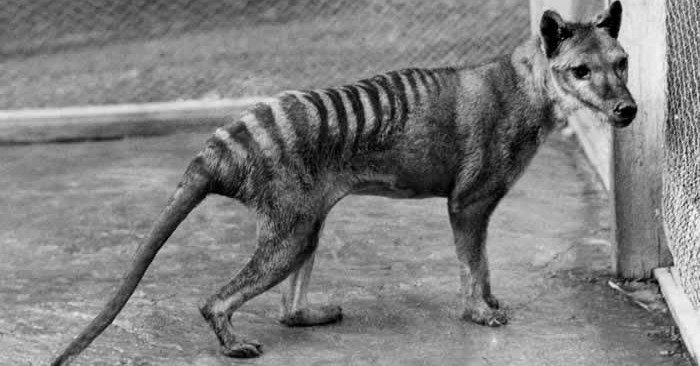Australia’s tiger, also known as the lost Tasmanian tiger, roamed the Australian bush almost 100 years ago before going extinct. But, thanks to modern science, Australia’s ‘tiger’ may be resurrected now instead of remaining lost.
Australia’s Tasmanian Tiger – No Longer Lost?

Australian Tasmanian Tiger, or Thylacine, (juvenile in foreground) pair in Hobart Zoo. Can scientists bring back Australias
tiger
from extinction?
©public domain – License
This carnivorous marsupial is officially known as a thylacine. It is also called a marsupial wolf, Australian Tasmanian tiger, Australias tiger, the Tasmanian tiger, or Tasmanian wolf. The thylacine is the largest carnivorous marsupial of recent times. Unfortunately, this one went extinct in 1938. Thylacines look like slender-faced foxes with yellowish brown fur. They also had 13 to 19 dark bars on the back and rump. Thylacines were nocturnal, with diets consisting of wallabies and birds. They were 39 to 51 inches long with a 20 to 26 inches long tail. Thylacines weighed between 33 to 66 pounds and had shallow pouches opening rearwards. Females carried two to four young at a time in these pouches. Their hind legs were longer than their forelegs, and their jaws had a large, almost 90-degree gape.
Thylacines roamed the Australian mainland and the wilds of New Guinea. However, they only lived in Tasmania in recent historical times, with their disappearance from the mainland probably due to their competition with dingoes. European settlers also hunted thylacines, who viewed them as a threat to their domestic sheep. By 1914, thylacines had become rare, with the last known living specimen dying in the Beaumaris Zoo in Hobart, Tasmania, in 1936. By this time, the government had granted them protected status, but it was too late. They became extinct in the wild in 1938.
How Will Scientists Resurrect Australia’s Tiger?

Advances in genetics, ancient DNA retrieval, and artificial reproduction may help to resurrect thylacines.
©Natali _ Mis/Shutterstock.com
The attempt to bring thylacines back to life will involve advances in genetics, ancient DNA retrieval, and artificial reproduction. Melbourne University professor Andrew Pask, head of its Thylacine Integrated Genetic Restoration Research Lab, is leading this initiative. Pask believes in protecting biodiversity and preventing other species from becoming extinct. However, he also voiced concerns that species losses were not slowing down. Pask added that technology provides science with the opportunity to correct the extinction of species in exceptional circumstances, replacing cornerstone species that no longer exist. Therefore, there is a chance to bring back Australia’s tiger.
This initiative is a collaboration between Colossal Biosciences and George Church. Tech entrepreneur Ben Lamm and George Church, a Harvard Medical School geneticist, are funding the Colossal Biosciences project. These partners are also working on another project. This other project focuses on bringing the woolly mammoth back to life in an altered form and has the support of a $15 million budget.
The Genetic Blueprint For Australia’s Tasmanian Tiger
This initiative will not be accessible outside of the team. However, they will use cutting-edge science and technology like gene editing and building artificial wombs. The scientists will first construct a complex genome of the extinct animal and compare it with the fat-tailed dunnart. The fat-tailed dunnart is a mouse-size carnivorous marsupial. It is also the thylacine’s closest living relative. Scientists will then compare the results to identify their differences. Pask explained this process by saying they would remove living cells from the dunnart. After removal of the cells, they will conduct DNA edits in each area where they differ from the thylacine’s DNA. According to Pask, they are engineering the dunnart cell to transform it into a Tasmanian tiger cell.
Once they have successfully programmed a cell, the team will then use stem cells and reproductive techniques involving dunnarts as surrogates. The approach aims to turn the programmed cell into a living animal. Pask said their end goal is to use technology to restore wild species that played critical ecosystem roles. He continued by saying their final hope is that current and future generations will see the Tasmanian tiger roaming the bushland again. Although the fat-tailed dunnart is much smaller than thylacines, this should not hinder the process as all marsupials give birth to extremely small young. The fat-tailed dunnart will then function as the surrogate mother to the baby thylacine in its early stages of life.
Cautious Reintroduction to the Wild of the Australian Tiger
If scientists want to reintroduce Australia’s tigers to their former habitats successfully, they will have to do so with caution. Pask said, ‘Any release such as this requires studying the animal and its interaction in the ecosystem over many seasons and in large areas of enclosed land before considering a complete rewilding.’ The initiative has no set time or goal, but it should not take too long. Furthermore, this initiative will benefit the extinct thylacine and other marsupials. They also face extinction due to intensifying bushfires in Australasia. Scientists can use existing technologies to resurrect extinct animals, producing ongoing and significant conservation benefits.
Bring Back The Australian Tiger? Easier Said Than Done!

Image of a juvenile male Australian Tasmanian tiger, thylacine, at Hobart Zoo taken by B Sheppard in 1928. The animal died the day after it was photographed.
©Benjamin A. Sheppard / public domain – License
Although the scientific methods for bringing back the Australian Tasmanian tiger seem promising, some people believe the project has significant limitations. Tom Gilbert is a professor at the University of Copenhagen’s GLOBE Institute. He is also a director of the Danish National Research Foundation’s Center for Evolutionary Hologenomics.
According to Gilbert, some genetic information will be missing from this experiment. This information will be missing because it is tough to recreate the complete genome of a lost animal from DNA contained in old thylacine skeletons. Additionally, Gilbert explains that this project will not be able to recreate the exact thylacine but rather an altered version of the Australian Tasmanian tiger – a hybrid animal.
Gilbert also maintains that scientists will have to pick what changes they want or have to make, resulting in a hybrid animal. Unfortunately, hybrid animals often have health problems. In addition, they may not be able to survive in the wild due to imperfect genetics.
Gilbert continued by saying, ‘To me, the real benefit of any de-extinction project such as this is the awesomeness of it. Doing it seems very justified to me simply because it will excite people about science, nature, and conservation. And we sure as hell need that in the wonderful citizens of our world if we are to survive into the future. But … do the stakeholders realize what they will get will not be the thylacine but some imperfect hybrid? We don’t need yet more people disappointed (or) feeling cheated by science.’
The photo featured at the top of this post is © iStock.com/Hein Nouwens
Thank you for reading! Have some feedback for us? Contact the AZ Animals editorial team.






